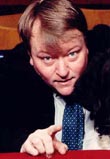|
|
This topic comprises 2 pages: 1 2
|
|
Author
|
Topic: Question for the pros... WHATS THAT SCRATCH???
|
Dave Williams
Wet nipple scene

Posts: 1836
From: Salt Lake City, UT, USA
Registered: Jan 2000
|
 posted 03-30-2002 03:11 AM
posted 03-30-2002 03:11 AM





This question has been bugging at me forever now.I am sure and hopeful that I am not insane, BUT, I am watching on DVD, the Good the bad and the ugly. In this, I am seeing something that I always saw in just about every single scope film during my tenure as a projectionist and manager, Especially the ones from fox.. WHat I am seeing, is at the bottom and/or top of the frame, during angle changes, a line of what could be called static. It appears literally for only one frame, and occurs only at an angle change. I noticed it was very heavy during Star Wars phantom menace. Does anyone know why this is? It cant be the projector, because it happens only on angle changes. Any clue helpful. John Pytlak, maybe you might have a clue? Dave
| IP: Logged
|
|
|
|
|
|
|
|
|
|
Steve Guttag
We forgot the crackers Gromit!!!

Posts: 12814
From: Annapolis, MD
Registered: Dec 1999
|
 posted 03-31-2002 08:56 AM
posted 03-31-2002 08:56 AM




If you use B&W "RP-40" With BH-1866 perforations (the ones that have rounded sides) then it is reasonable to expect the framing to be off in relation to a release print. The BH-1866 perforation and pitch are only supposed to be used for negatives, which 35-PA is. Unfortunately, that isn't what projectors are running. Projectors expect KS-1870 perforations which have a longer pitch and a positive perforation. Since 35-PA is used to also set up Telecines which pin-register to BH-1866 perforations, SMPTE made a test film that would "work" for both worlds. I have put forth a posistion paper to the SMPTE that, among other things, requests using KS-1870 perforations as the standard for 35-PA with the short pitch BH-1866 film as a special request for lab use. I believe you will find that the color version of "RP-40" called 35-IQ is on KS-1870 perforations and will more closely represent release prints. Another thing to note when using test film to register framing for releae prints...some labs use bi-directional printers. As such if one reel was printed in the forward direction and the next reel was printed in the reverse direction, there will be a vertical shift equal to the slop of the sprocket tooth within the perforation so don't expect the framing to be "perfect" all the way through the show no matter how you set it up. Stev ------------------
"Old projectionists never die, they just changeover!"
| IP: Logged
|
|
|
|
|
|
|
|
|
|
|
|
|
|
|
|
|
|
|
|
|
|
All times are Central (GMT -6:00)
|
This topic comprises 2 pages: 1 2
|
Powered by Infopop Corporation
UBB.classicTM
6.3.1.2
The Film-Tech Forums are designed for various members related to the cinema industry to express their opinions, viewpoints and testimonials on various products, services and events based upon speculation, personal knowledge and factual information through use, therefore all views represented here allow no liability upon the publishers of this web site and the owners of said views assume no liability for any ill will resulting from these postings. The posts made here are for educational as well as entertainment purposes and as such anyone viewing this portion of the website must accept these views as statements of the author of that opinion
and agrees to release the authors from any and all liability.
|

 Home
Home
 Products
Products
 Store
Store
 Forum
Forum
 Warehouse
Warehouse
 Contact Us
Contact Us




 Printer-friendly view of this topic
Printer-friendly view of this topic














 ). Once I locked my framing knobs down I never noticed the "negative splices" again. And our apertures (most of them) were cut properly.
). Once I locked my framing knobs down I never noticed the "negative splices" again. And our apertures (most of them) were cut properly.





